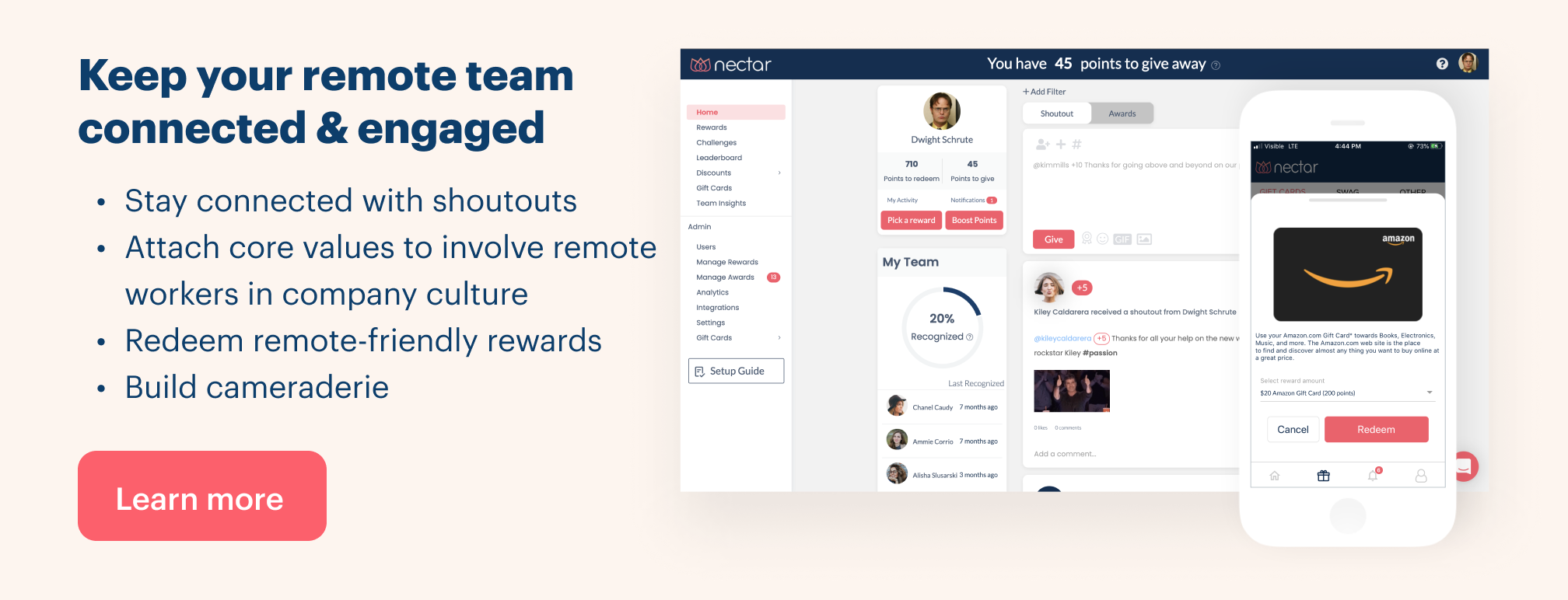6 Meaningful Ways to Keep Employees Connected in a Remote Workplace

During the COVID pandemic, just 25 percent of workers were doing their jobs in the office.
The majority had transitioned to working from home. As the pandemic subsides, many organizations are embracing the remote workplace and the benefits that come with it.
According to one survey, up to 70 percent of employers plan to develop a hybrid workplace. But to get the most from your employees and keep them productive, you need to be aware of the challenges they face.
One of the biggest challenges is building connections among a team that works in different locations and possibly time zones. To be prepared, you need to know how to keep employees connected while working from home—and no, getting Slack or Microsoft Teams isn’t enough.

Are your remote employees at risk of feeling disconnected?
The good side of remote work
According to research done by Buffer, 98 percent of employees want to continue working from home for most of their careers. A survey by Flexjobs found that 58 percent of respondents wanted to work from home on a full-time basis, while 39 percent wanted a hybrid scenario.
However, as much as employees enjoy the freedom and flexibility of working from home, there are some drawbacks.

The dark side of working from home
A recent report by USA Today claims that 60 percent of people said they were suffering from loneliness prior to the pandemic. It’s reasonable to assume that working from home has not improved that statistic.
Instead, social isolation has been known to be a negative result of telecommuting or remote work situations for some time. Researchers have said that: “we use other people as social barometers. The reduction of this barometer or measure of ourselves is significant for teleworkers.”
A survey of remote workers by Buffer found that 20 percent indicated loneliness was one of the biggest challenges. And research by Gallup compared employees who work from home with those in a hybrid role and those who work fully in-office. Feelings of loneliness were highest in employees who worked from home full-time.
So how can we lean into the good side of remote work (flexibility, focus) while mitigating the bad side (loneliness, feelings of disconnection, burnout)? Let’s look at six tactics organizations can employ to increase feelings of connectedness.

6 ways to help employees stay connected while working from home
Employers can help employees mitigate feelings of isolation and loneliness by helping them build connections. Here are six ways that you can encourage your employees to stay connected if they work from home.
1. Drop-in office hours
Set aside some time for remote employees to drop by the office during the week. This time can be social, such as meeting up with other co-workers, or it can be more formal, such as talking to company representatives about their questions or challenges.
2. Live working sessions
Virtual tech is not just for team meetings. Consider offering live working sessions where everyone leaves their cameras on while working. This can create an atmosphere that is more like a traditional office.
3. Encourage employee recognition
Acknowledging employees' efforts still remains a meaningful way to build loyalty and higher engagement levels. When you recognize the work and achievements of your employees, they are less likely to leave. And they will be encouraged to give their best in the future.
There are a variety of ways that you can implement an employee recognition program in your remote workplace through Nectar’s platform. From social recognition to awards to perks, letting your employees know how much you value their efforts can go a long way to helping them stay connected while working from home.

4. Encourage employees to form resource groups
Remote employees should be encouraged to cultivate connections among themselves and form employee resource groups or ERGs. These groups help employees get to know others from similar backgrounds and identities, such as ERGs for women. They are a key way that remote workers stay connected while working from home. For employees who are not familiar with how to begin an ERG, Together has published some of the best practices for ERGs to help.
5. Pair employees in a mentoring program
Moving to remote workplaces led many organizations to adapt their practices, including mentorships. Remote workplace mentoring programs offer a lot of benefits for participants and employers.
Consider a study by Google that showed employees who made mentoring connections early on had productivity gains even five years later compared to peers. Likewise, companies have increased retention rates by 49% after starting mentoring programs.
Consider implementing a remote employee mentorship program instead of losing the opportunity to help your employees build skills and connections while they work from home. Pairing employees together in a mentoring program can help them avoid feelings of isolation and work towards their career goals.

6. Ask for feedback and ideas from employees
Let your employees know that they matter to your organization by inviting them to offer input and ideas on wellness activities to participate in while working from home.
You can send them surveys every quarter to gather their opinions. Remote employees may be able to offer some insight that company leadership does not have.
It’s also important to thank employees for their feedback and act on it. Put some of the ideas into play for your remote team and see if you’re able to help them build connections, which lead to better collaboration.

Begin building a better remote work environment
Companies have been adapting to changing demands of employees who are hoping to work from home on a more permanent basis when the pandemic has ended. However, creating a thriving remote team means addressing some issues and challenges that in-office employees don’t face. One of those is isolation and a lack of connection.
Research has found that while employees enjoy the perks of working from home, they miss out on the opportunity to connect with co-workers. There are many ways to overcome this challenge and help employees stay connected with working from home. These include:
- Live working sessions
- Recognizing employee efforts
- ERGs
- Mentoring programs
- Invite employee feedback
When you build connections into your remote workplace activities, you’ll find happier, more loyal and more dedicated employees. And ultimately, you’ll be cultivating collaboration among your team and higher productivity levels.















